American black bear population fragmentation detected with pedigrees in the transborder Canada–United States region
IF 0.8
4区 生物学
Q4 ZOOLOGY
引用次数: 37
Abstract
Abstract: Population fragmentation is stressing wildlife species worldwide. In populations with minimal genetic structure across potential fractures, detecting fragmentation can be challenging. Here we apply a relatively unused approach, genetic pedigree analysis, to detect fragmentation in the American black bear (Ursus americanus) across 2 highway corridors that are bordered by large, contiguous populations. We compared our results with movements detected through Global Positioning System (GPS) telemetry of collared bears between 2005 and 2010. We used 20-locus microsatellite genotypes to identify 104 first-order relatives (parent–offspring or full siblings) within 383 black bears, sampled between 2002 and 2012. We compared numbers of pairs of immediate relatives found on either side of 2 highways—U.S. Highway 2 in northwestern Montana, USA, and BC Highway 3 in southeastern British Columbia, Canada—with an expected rate, the mean across 22 lines parallel to each highway at 1-km intervals. We found that over similar geographic scales, dispersal was lower across the transportation corridors than adjacent areas without a highway corridor. The observed number of migrants across Highway 2 was 3, well below the confidence interval of the expected number of 15.1 migrants/available bears (95% CI = 12.2–18.0). Highway 3 had 6 migrants, compared with the expected 13.1 bears (95% CI = 10.8–15.5). None of 16 black bears wearing GPS radiocollars for 1 year crossed Highway 2, yet 6 of 18 crossed Highway 3. These results suggest that even though 33% of radiocollared black bears crossed Highway 3, there appeared to be less dispersal across the transportation corridors than across other regions in the study area. Pedigree and telemetry results were more closely aligned in the Highway 2 system, with both methods suggesting more intense fragmentation than we found along Highway 3. Our results identified pedigree analysis as another tool for investigating population fragmentation, particularly in situations where genetic differentiation is too weak to determine migration rates using individual-based methods, such as population assignment.在加拿大-美国边境地区用血统检测到的美洲黑熊种群分裂
摘要/ Abstract摘要:种群破碎化正在给全球野生动物物种带来压力。在潜在骨折的遗传结构最小的人群中,检测断裂可能具有挑战性。在这里,我们采用了一种相对未被使用的方法,遗传谱系分析,来检测美洲黑熊(Ursus americanus)在2条高速公路走廊上的碎片化,这些走廊被大型连续种群所包围。我们将研究结果与2005年至2010年间通过全球定位系统(GPS)遥测检测到的戴项圈熊的运动进行了比较。我们利用20个位点的微卫星基因型对2002年至2012年取样的383只黑熊进行了104个一级亲缘关系(亲代或全兄弟姐妹)鉴定。我们比较了在美国和美国两条高速公路两侧发现的直系亲属的数量。美国蒙大拿州西北部的2号高速公路和加拿大不列颠哥伦比亚省东南部的3号卑诗高速公路-按照预期速度,平均跨越22条平行于每条高速公路1公里的线。研究发现,在相似的地理尺度上,交通走廊的分散程度低于相邻无公路走廊的地区。2号公路上观察到的迁徙者数量为3只,远低于15.1只迁徙者/可用熊的预期数量的置信区间(95% CI = 12.2-18.0)。3号公路有6只迁徙熊,而预期有13.1只熊(95% CI = 10.8-15.5)。佩戴GPS无线项圈的16只黑熊1年内没有一只穿过2号高速公路,但18只中有6只穿过3号高速公路。这些结果表明,尽管33%的戴着放射性项圈的黑熊穿过3号公路,但在研究区域内,它们在交通走廊上的分布似乎比在其他地区要少。谱系和遥测结果在2号公路系统中更为接近,两种方法都表明比我们在3号公路上发现的更强烈的碎片化。我们的研究结果表明,谱系分析是研究群体碎片化的另一种工具,特别是在遗传分化太弱而无法使用基于个体的方法(如群体分配)确定迁移率的情况下。
本文章由计算机程序翻译,如有差异,请以英文原文为准。
求助全文
约1分钟内获得全文
求助全文
来源期刊

Ursus
生物-动物学
CiteScore
2.00
自引率
15.40%
发文量
12
审稿时长
>12 weeks
期刊介绍:
Ursus includes a variety of articles on all aspects of bear management and research worldwide. Original manuscripts are welcome. In addition to manuscripts reporting original research, submissions may be based on thoughtful review and synthesis of previously-reported information, innovative philosophies and opinions, and public policy or legal aspects of wildlife conservation. Notes of general interest are also welcome. Invited manuscripts will be clearly identified, but will still be subject to peer review. All manuscripts must be in English. All manuscripts are peer-reviewed, and subject to rigorous editorial standards.
 求助内容:
求助内容: 应助结果提醒方式:
应助结果提醒方式:


